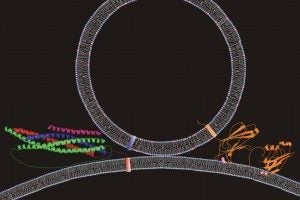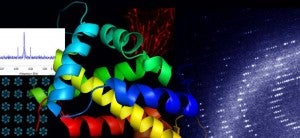Biophysics & Structural Biology
Biophysics
 Research in Biophysics at UVA utilizes quantitative approaches to understand the physical and chemical basis of complex biological processes. Biological processes are studied at every level and across many fields, from the theoretical to the experimental.
Research in Biophysics at UVA utilizes quantitative approaches to understand the physical and chemical basis of complex biological processes. Biological processes are studied at every level and across many fields, from the theoretical to the experimental.
The Biophysics Graduate Program at the University of Virginia is one of the oldest in the country. We employ a wide range of experimental and computational approaches in a highly interactive and multidisciplinary environment. One of our strengths is in the study of membranes, which are of fundamental importance for biological systems. Membranes compartmentalize the cell, thereby controlling the internal cellular environment. They are sites for energy transduction and signaling. Finally, many regulatory processes take place at membrane surfaces.
Students in biophysics at UVA gain a strong foundation in biophysical approaches and analysis through innovative research and didactic coursework.
Structural Biology
 Research in Structural Biology at UVA seeks to acquire a thorough understanding of biological function by gaining a detailed knowledge of the structure of the macromolecules that comprise the machinery of life.Students interested in Structural Biology pursue research designed to determine the 3D structures of proteins and nucleic acids using a variety of methods, including nuclear magnetic resonance spectroscopy, x-ray crystallography, electron microscopy, and electron paramagnetic resonance spectroscopy. Through the use of these different structural methodologies, we are able to gain unique and complementary information about the structure of macromolecules. These structures, in turn, provide important insights into the molecular basis of function and provide a framework for the design of experiments to address biological processes involving the macromolecules under investigation. Structures of medically relevant targets can also play a critical role in accelerating the process of drug design through the use of structure-based lead compound discovery.
Research in Structural Biology at UVA seeks to acquire a thorough understanding of biological function by gaining a detailed knowledge of the structure of the macromolecules that comprise the machinery of life.Students interested in Structural Biology pursue research designed to determine the 3D structures of proteins and nucleic acids using a variety of methods, including nuclear magnetic resonance spectroscopy, x-ray crystallography, electron microscopy, and electron paramagnetic resonance spectroscopy. Through the use of these different structural methodologies, we are able to gain unique and complementary information about the structure of macromolecules. These structures, in turn, provide important insights into the molecular basis of function and provide a framework for the design of experiments to address biological processes involving the macromolecules under investigation. Structures of medically relevant targets can also play a critical role in accelerating the process of drug design through the use of structure-based lead compound discovery.
Structural biology laboratories at the University of Virginia have established strengths in integral membrane proteins, structural genomics, cell signaling factors, as well as macromolecular assemblies such virus particles and filaments.
Faculty
Agaisse, Herve
Genetic approaches, cellular and molecular biology of intracellular pathogen infection
Bao, Huan
Biophysics of membrane pore formation; research and therapeutic applications of lipid nanoparticles.
Bayliss, Douglas A.
Mechanisms of neuromodulation in central neurons
Bekiranov, Stefan
Computational Biology; Bioinformatics; Precision Medicine; Machine Learning/AI; Quantum Computing
Bourne, Philip E
Data Science
Bushweller, John H.
Drug Development Targeting Transcription Drivers in Cancer; Structure/Function Studies of Transcription Factor Drivers in Cancer
Cafiso, David S.
Molecular Mechanisms for Membrane Transport and Cell Signaling
Columbus, Linda
Biophysical Chemistry: Membrane protein structure, function, and dynamics
Derewenda, Zygmunt S.
Structure-function relationships in proteins
DuBay, Kateri H.
The design of self-assembling nanomaterials
Egelman, Edward H.
Structure and Function of Macromolecular Complexes Using Electron Microscopy
Flowers, Sarah
Impact of APOE and lipid metabolism on cell function in Alzheimer's disease.
Gahlmann, Andreas
Super-resolution fluorescence imaging of bacterial cells
Gan, Lu
Chromosome organization; Nucleosome structure; Histone marks; Structural cell biology
Jomaa, Ahmad
Localisation of nascent proteins to sub-cellular compartments
Kedes, Dean H.
Human Herpes virus associated with malignancy, including Kaposi's Sarcoma
Keller, Raymond E.
Cellular and molecular mechanisms of morphogenesis
Kenworthy, Anne
Architecture and function of biological membranes
Landers, James P.
Bioanalytical Chemistry on Microchips
Levental, Ilya
Composition, Biophysics and Physiology of Cellular Membranes
Minor, Wladek
Structure-Function Relationships in Macromolecules; Infectious Diseases and Drug Discovery; Bioinformatics and Big Data; Scientific Reproducibility
Peirce-Cottler, Shayn M.
Tissue Engineering and Regeneration, Computational Systems Biology, Vascular Growth and Remodeling, Stem Cell Therapies
Pompano, Rebecca
Bioanalytical tools for inflammatory disease
Qi, Ling
Delineate the physiological importance and structure-function relationship of ER-associated degradation in humans.
Redemann, Stefanie
Chromosome segregation and aneuploidy in meiosis and mitosis
Rekosh, David M.
Human Immunodeficiency Virus Gene Expression; Human Endogenous Viruses; SARS-CoV-2 Protein Trafficking; Post-transcriptional Gene Regulation
Somlyo, Avril V.
biophysics, biophysics & structural biology, cardiovascular biology, and physiology
Sonkusare, Swapnil
Identify the calcium signaling abnormalities that lead to vascular dysfunction and blood pressure elevation in cardiovascular disorders
Tak, Uday
Prokaryotic immune systems, bacteriophage virology, programmed cell death, pore-forming proteins, evolution of immunity, protein engineering
Tamm, Lukas K.
Biomembrane Structure and Function; Cell Entry of Enveloped Viruses; Neurosecretion by Exocytosis; Structure of Bacterial Pathogen Membrane Proteins; Lipid-Protein Interactions
Tsai, Ming-Feng
Membrane-transport physiology and biophysics
Weaver, Tyler M.
Mechanisms of DNA repair in chromatin
Whitlock, Jarred M
The formation, function, coordination, and pathology of multinucleated cell types that make up the placenta and musculoskeletal system.
Xie, Jinghang
Molecular Imaging; Cancer Immunology; Vaccines; Antibiotic Resistance.
Yang, Jie
Structural mechanisms of macromolecular complexes, Cryo-EM, Mitochondrial stress, Endoplasmic reticulum stress, Cellular stress response
Zang, Chongzhi
Bioinformatics methodology development; Epigenetics and chromatin biology; Transcriptional regulation; Cancer genomics and epigenomics; Statistical methods for biomedical data integration; Advanced machine learning; Theoretical and computational biophysics
Zimmer, Jochen
Transport of biopolymers across biological membranes with a particular interest in polysaccharide and protein translocation.
